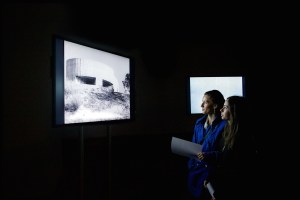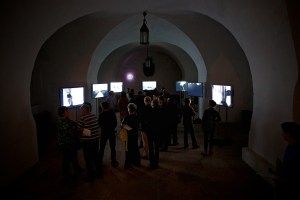

Women and children receive treatment, in the municipal hospital of M'banza Congo, Zaíre province. Credit: USAID
Malaria is often represented through the depiction of mosquitoes or sick women and children. Overfamiliarity with such imagery can result in blindness to the importance of current research.
When I began working with the Wellcome Trust Sanger Institute’s Public Engagement team on an arts project around malaria, I knew I wanted to create a work that would directly engage the senses and provoke a thinking process. However, it was some way into the project before I formed a clear direction for the artwork.
The research phase

Image from a report on the prevention of malaria in Mauritius, 1908. Credit: Ronald Ross, Waterlow and Sons Ltd, the Wellcome Library
Before my three, week-long residencies at the Sanger Institute’s malaria laboratory, I prepared by reading historical accounts and current research and by looking through intriguing documents and images at the Wellcome Library.
At the Sanger Institute, I was given a rare opportunity to find out at first-hand how Julian Rayner, Oliver Billker and their teams worked and to learn about their research. During this time, I continued to research archives, which provided a rich source of compelling imagery. My attention was captured by films - often undigitised - made during a previous malaria eradication campaign.
Alongside this immersion in a mass of new information, I was trying to form a concept based on experimentation with material in my studio. On occasion I was asked by my collaborators what the work would be – for much of the time, I simply didn’t know.
Art in progress
I spent time collecting scientific material, such as data, movies and sound recordings of mosquitos, and exploring them. For example, I projected a film of the parasite development within the mosquito gut onto copies of old photographs to see how different visual languages worked together. I wanted to explore the aesthetic potential of these relationships.
Julian and Oliver viewed these in-progress experiments, raising questions about issues such as the role of emotion versus emotional detachment within research. These were some of the best and most helpful conversations, pushing me to define my position as an artist more clearly.
Watching the parasite’s process
While I was with the team in the labs, I was shown scientific films depicting the movements of the parasite at the ookinete stage while in the mosquito gut. I was also shown how software had been used by Oliver’s team to track this movement. I responded to the ambiguity of the marks showing these movements: were they traces linked to purposefulness, or more random actions? I was also intrigued by their visual beauty — thin lines etched across a darkened surface, suggesting a gradual process of erasure of the host surface.
Around the same time, in conversation with Julian, I learned that anaemia, one of the most common clinical symptoms of malaria, can be picked out by the naked eye, whereas many of the parasite’s actions are hidden, revealed only by imaging technology. Anaemia can cause a bleached out appearance of the skin of malaria sufferers; this was of interest to me as I sought a visual metaphor that might embrace the complex processes of the disease and its broader effects. These extend well beyond the individual, causing partial erasure of family and social ties as well as economic structures.
Analysis and archival imagery
These ideas, coupled with the archival film I had uncovered in my research, became the basis of the artwork. They set in motion the idea of creating a software parasite that would erode visual imagery. The software parasite concept was a solution to problems I had identified for myself at the beginning of the work: how can I avoid the indulgence of personal expression/emotion in response to malaria? How can I divorce my ideas from emotive, mediated images of the disease?
The software parasite placed agency within the domain of the non-human, so I felt it was important to find a means of giving it autonomy, of making it an entity in pursuit of its own ends, by using authentic data to power its actions. In conversation with Julian, Oliver and artist David Strang, who works with sound and programming (David also composed the sound track for the installation), a data set from the early 20th century was selected that captured the waxing and waning of parasite levels over time in individuals suffering from malaria.
The final work
Two inputs create the final film output; one is a data feed of parasite numbers across a 20-day period and the other is the archive film. The film is processed by the software, which detects edges in the images where the tonal contrast is strong. Once an edge has been detected, it becomes the point for infection and the film is manipulated from this point according to the strength of parasite numbers in the data.
As the parasite numbers rise in the data, the effect of the infection increases and registers as a visual process of erasure. Gradually, more and more of the image is obscured by white marks tracking the parasite burden.
The final work is an audio visual installation. Across multiple screens short sections of film play on loops. Each is affected by the parasite data in a continuous and iterative process. The parasite’s pattern of replication within each film loop is different. This creates a sense that each section of film is like an individual acting as a site for the disease and actions of the parasite.
By avoiding the use of familiar images of malaria, I was able to view the disease in terms of the biological process rather than just the disease effects. This way of seeing was influenced by working with researchers who must understand how the parasite operates in order to battle this deadly disease.
Deborah Robinson is an Associate Professor (Reader) in Contemporary Art at Plymouth University.
Deborah worked in collaboration with the Wellcome Trust Sanger Institute to produce 'Parasite', an audio-visual installation. The artwork was exhibited in June 2103 at the Anglia Ruskin Gallery, was winner of the 2013 Shanghai International Science and Art Award for Excellence, exhibited at ICIA Bath, March 2014, and in May 2014 at Heidelberg Castle, Germany. It was also funded by Arts Council England, and supported by a fellowship with the ESRC UK Genomics Forum.
Related Links:
-
- A film of the installation can be found here
- A film exploring the collaboration between Deborah and Sanger Institute scientists can be found here
- Sanger Institute Public Engagement
- Sanger Institute Malaria Programme
- Deborah Robinson's profile at the Plymouth University website











